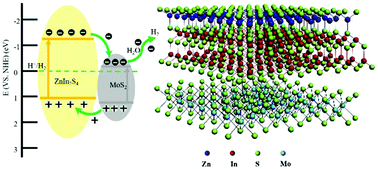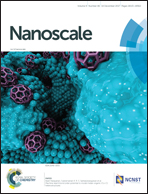A 2D self-assembled MoS2/ZnIn2S4 heterostructure for efficient photocatalytic hydrogen evolution†
Abstract
Semiconductor photocatalysis for hydrogen production is a promising route to address current energy demands. It is still a great challenge to spatially separate photogenerated electrons and holes in bulk photocatalysts because of the long carrier transport pathway from the bulk to the surface. 2D heterostructured photocatalysts with the type II band alignment can not only shorten the carrier transport pathway, but also create an electric field at the interface to suppress the carrier recombination. However, ultrathin and intimate-contact 2D heterostructured photocatalysts have rarely been achieved so far. Herein, we reported that ZnIn2S4 nanosheets were self-assembled on few-layer MoS2 nanosheets to fabricate ultrathin and intimate-contact 2D heterostructured photocatalysts. This 2D heterostructure was formed thanks to the strong electrostatic adsorption between MoS2 and ZnIn2S4. Under visible light irradiation, the H2 evolution rate of 2D MoS2/ZnIn2S4 heterostructured photocatalysts can reach 8898 μmol g−1 h−1, which is almost 16 times higher than that of the pure ZnIn2S4 photocatalysts. The dramatically enhanced photocatalytic performance was ascribed to the better charge separation and the accelerated surface reaction due to the heterostructure and more active sites provided by MoS2. These results provided a new insight for the design and development of 2D heterostructured photocatalysts.



 Please wait while we load your content...
Please wait while we load your content...